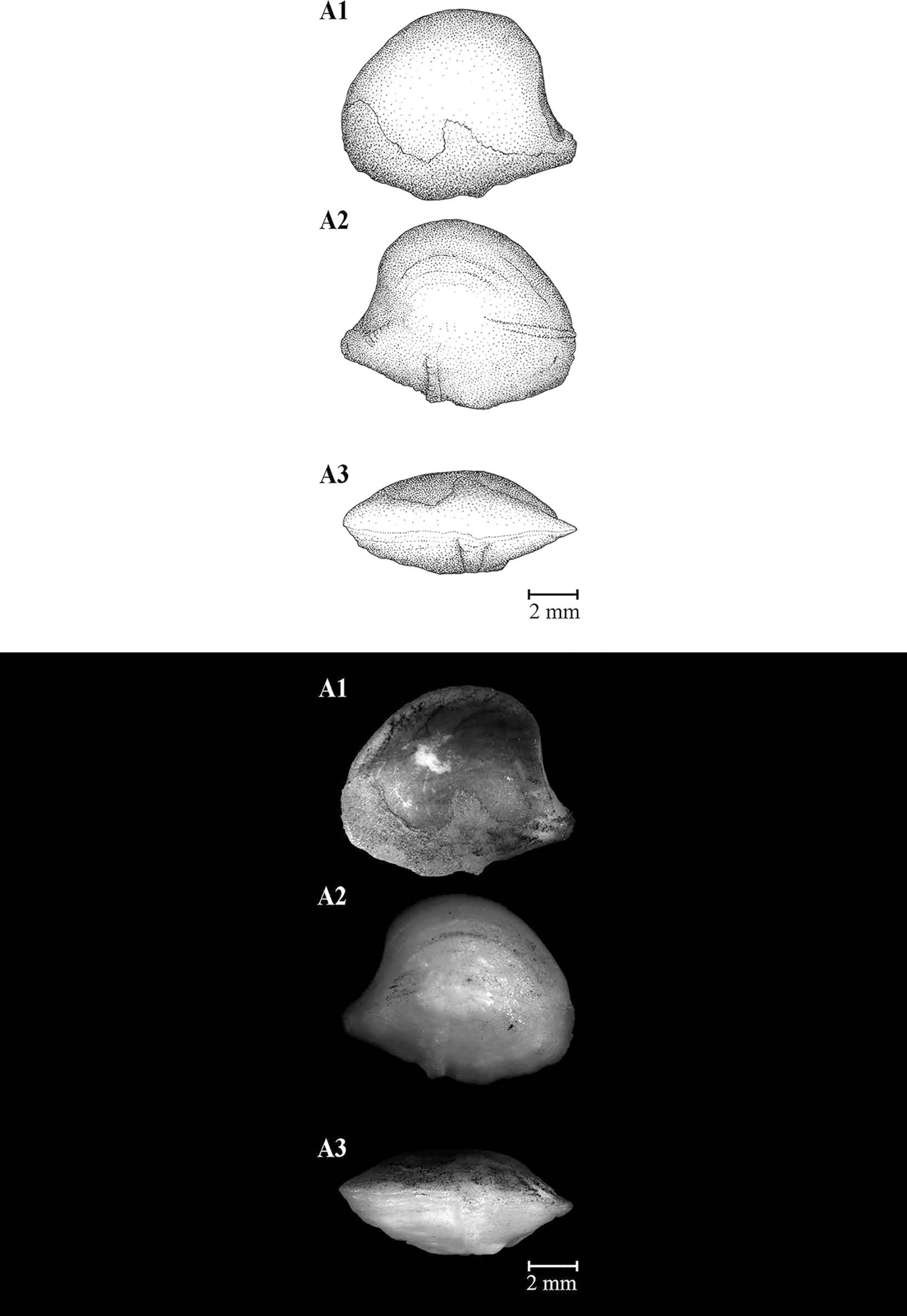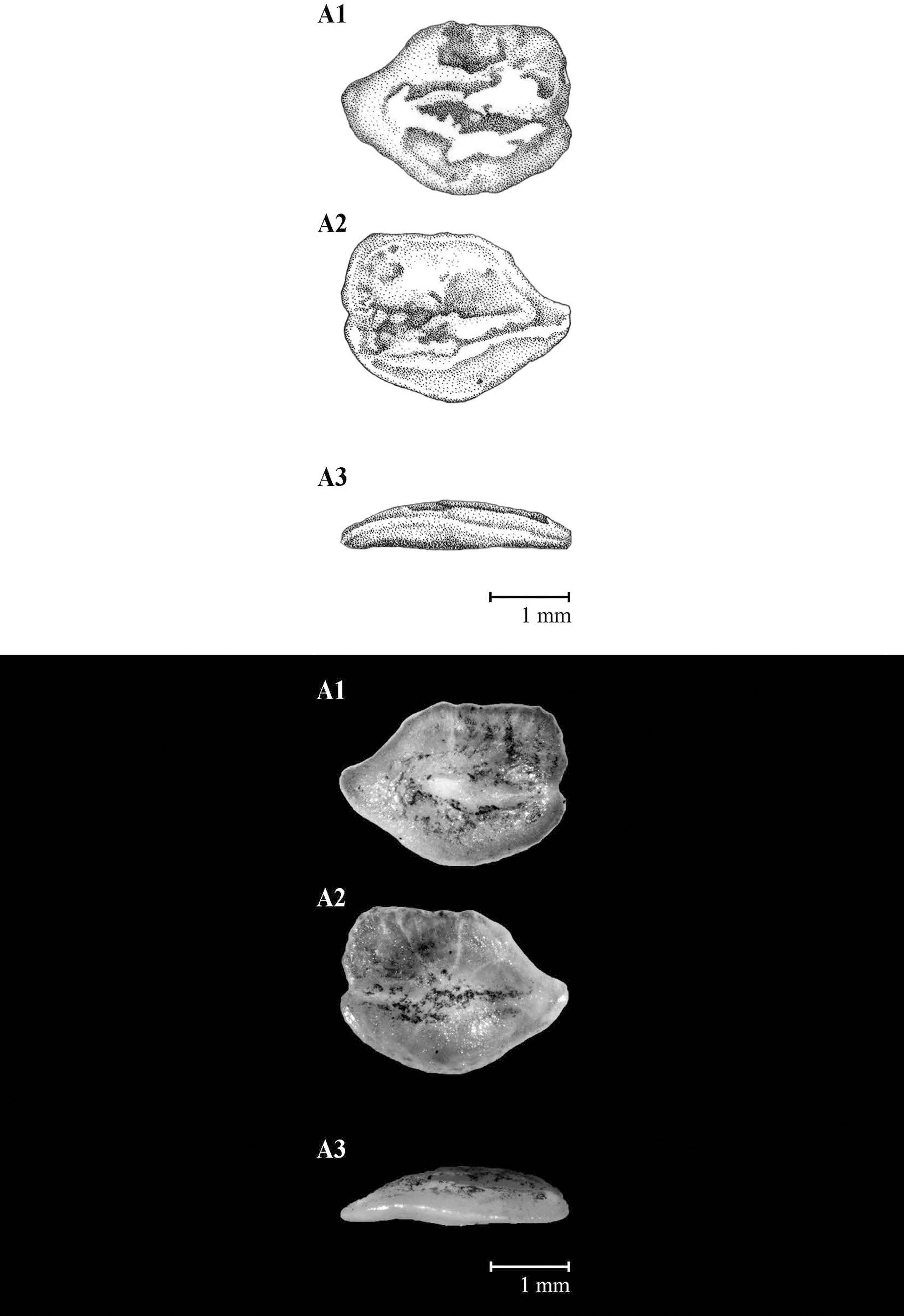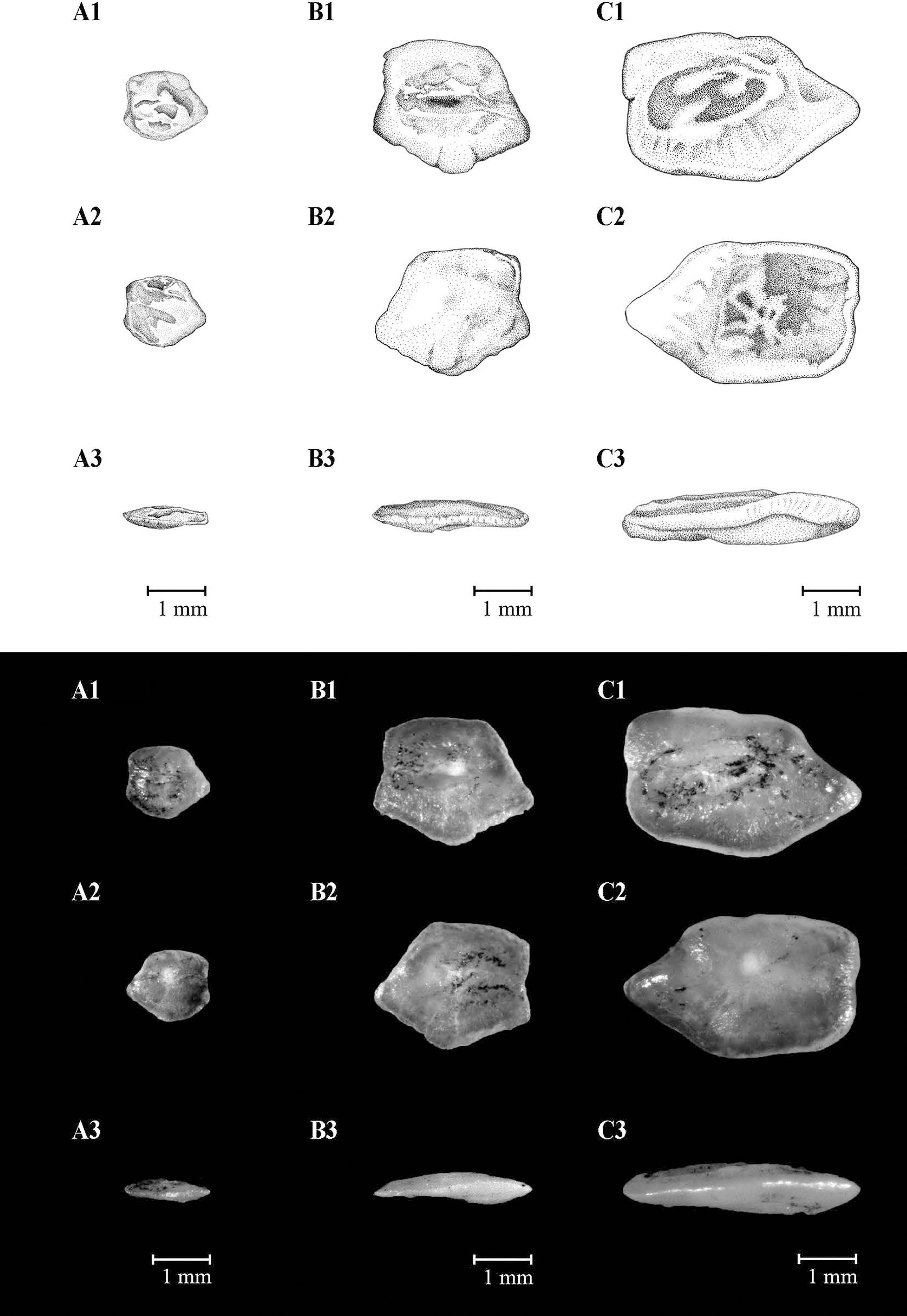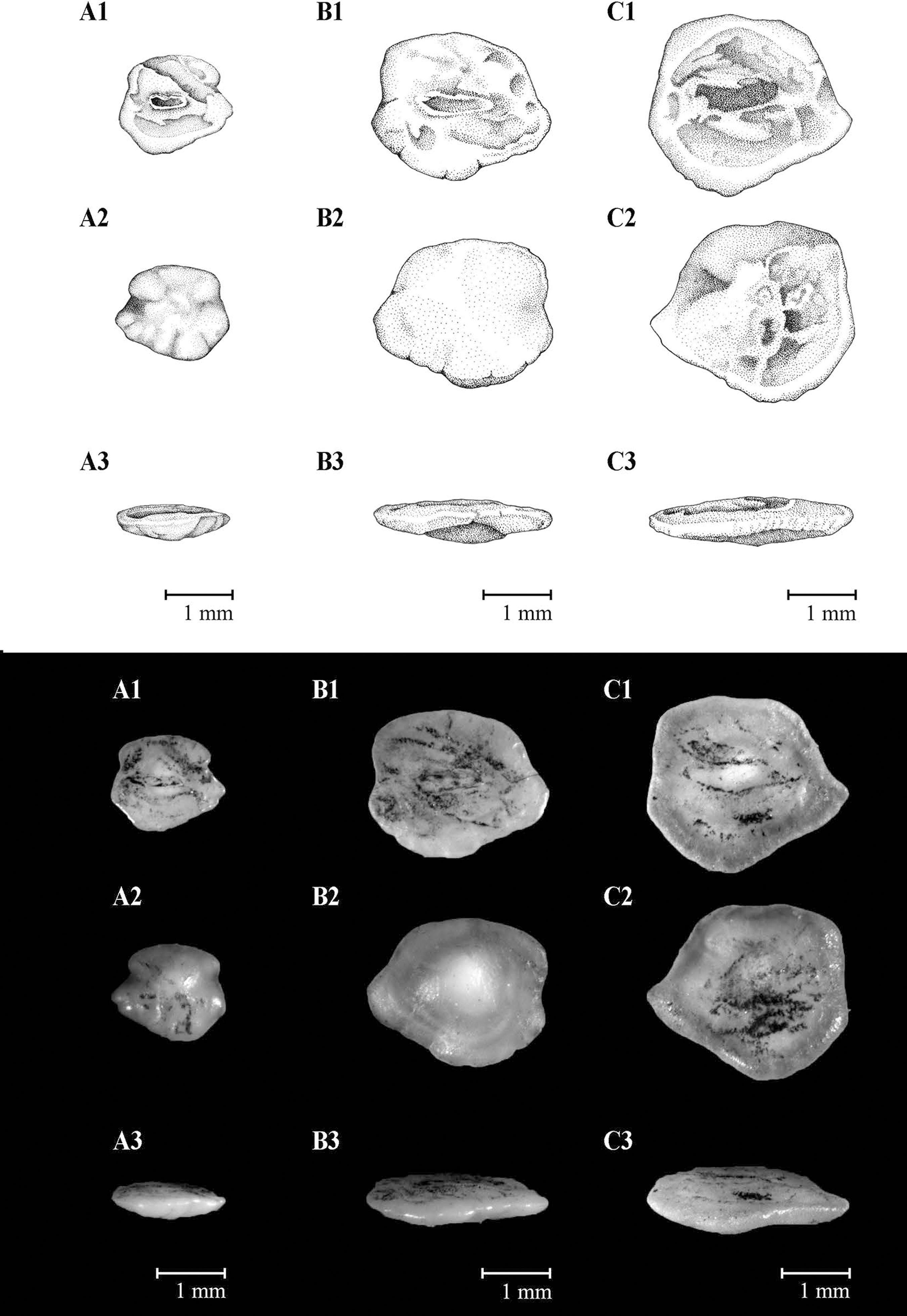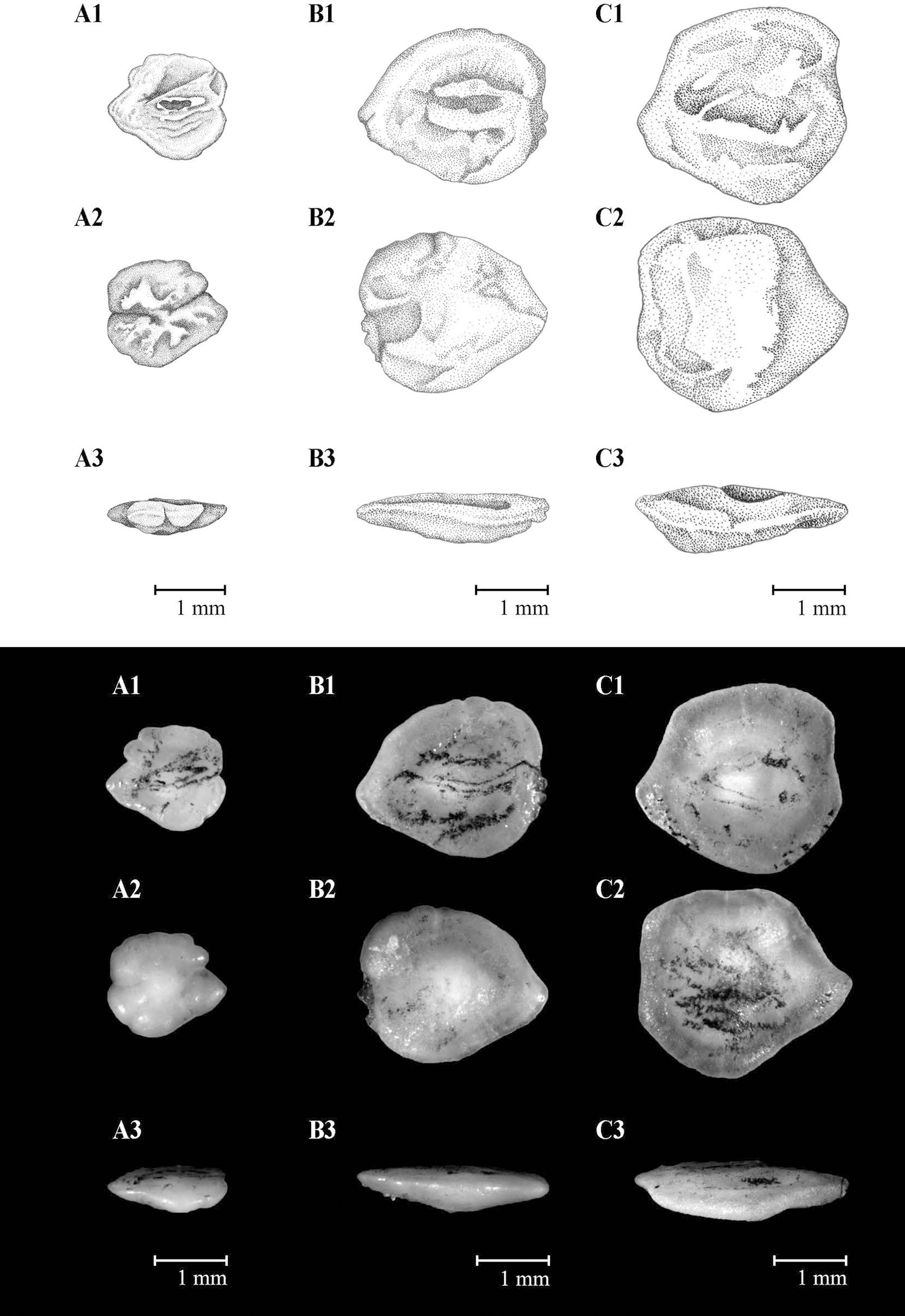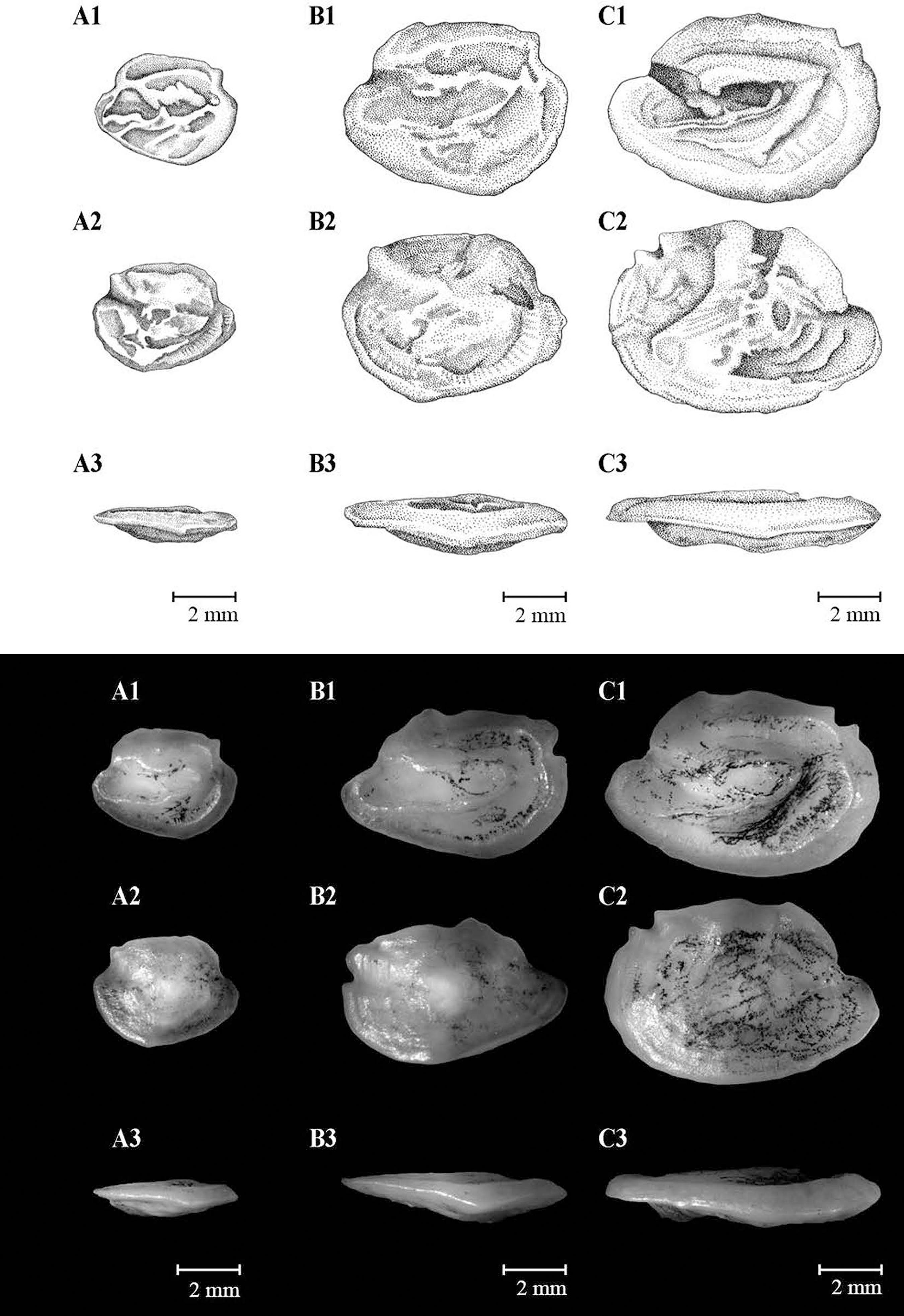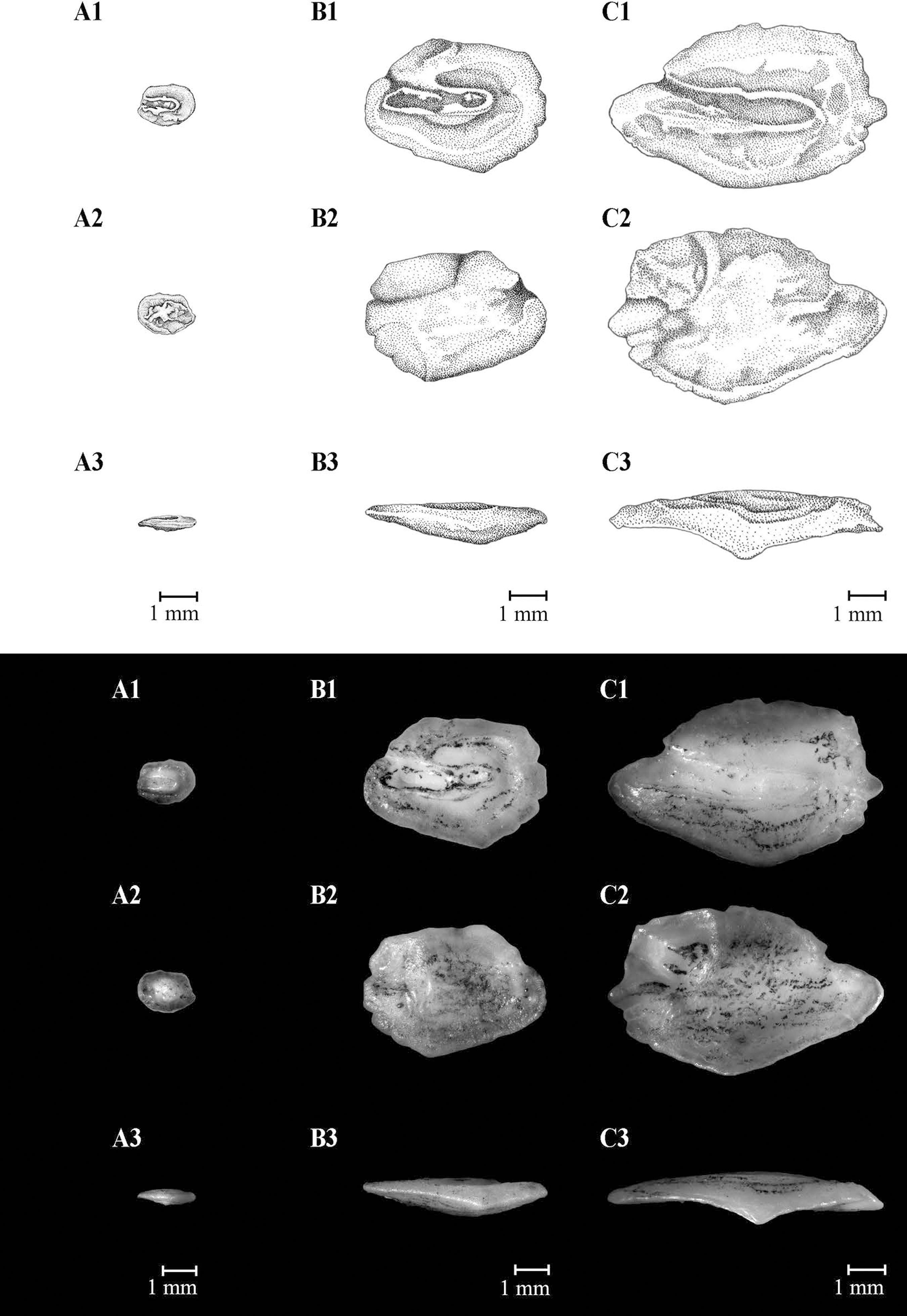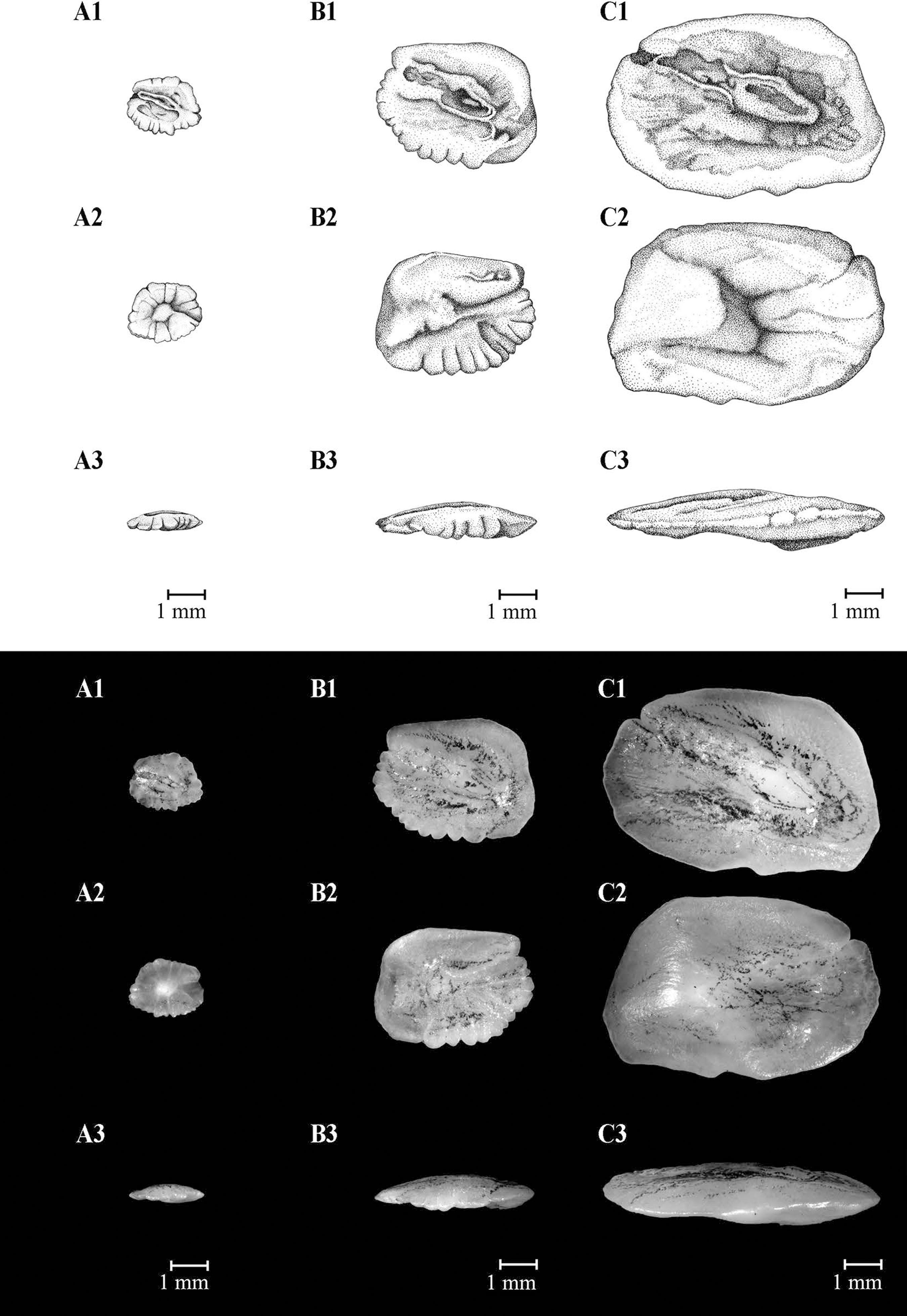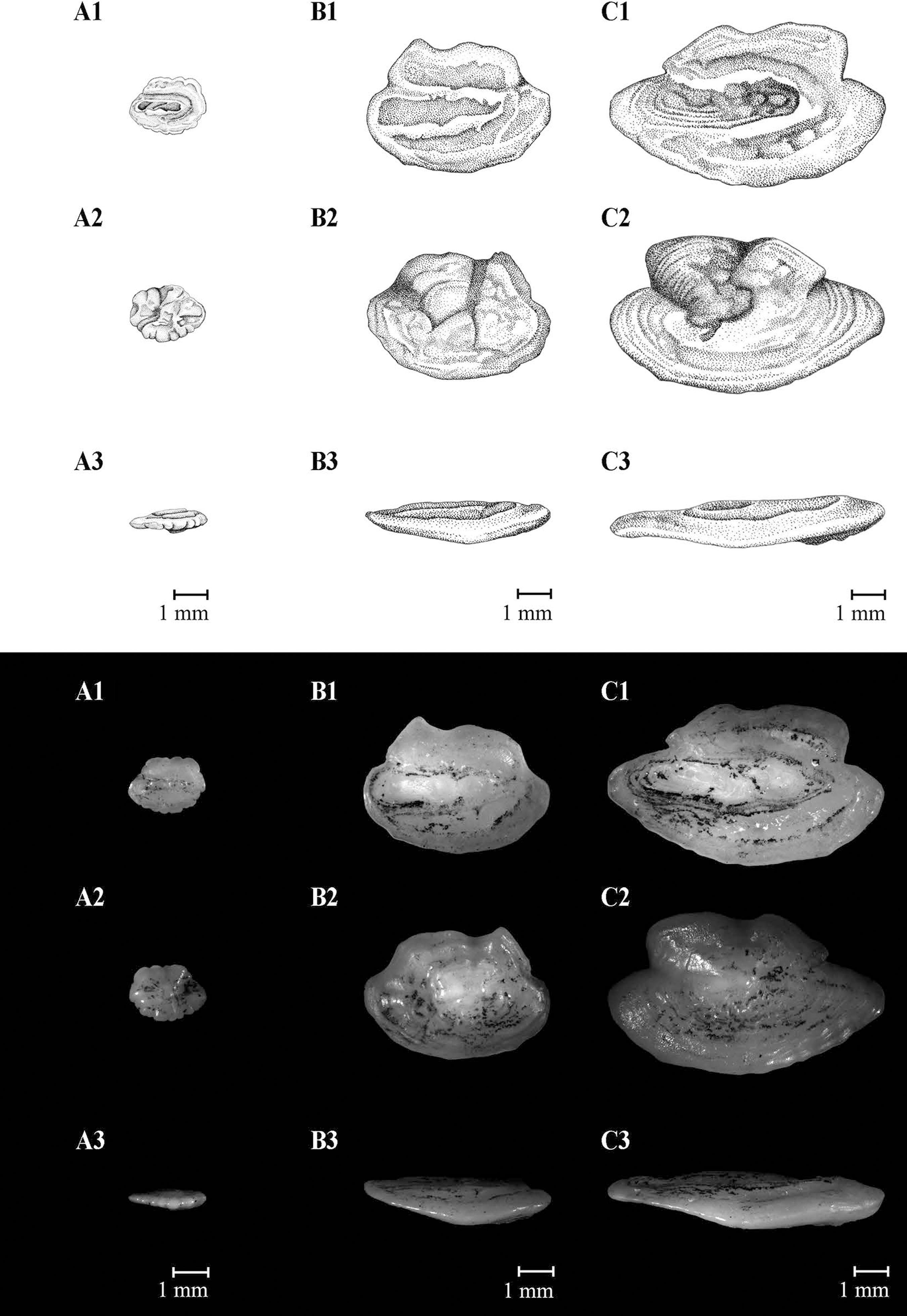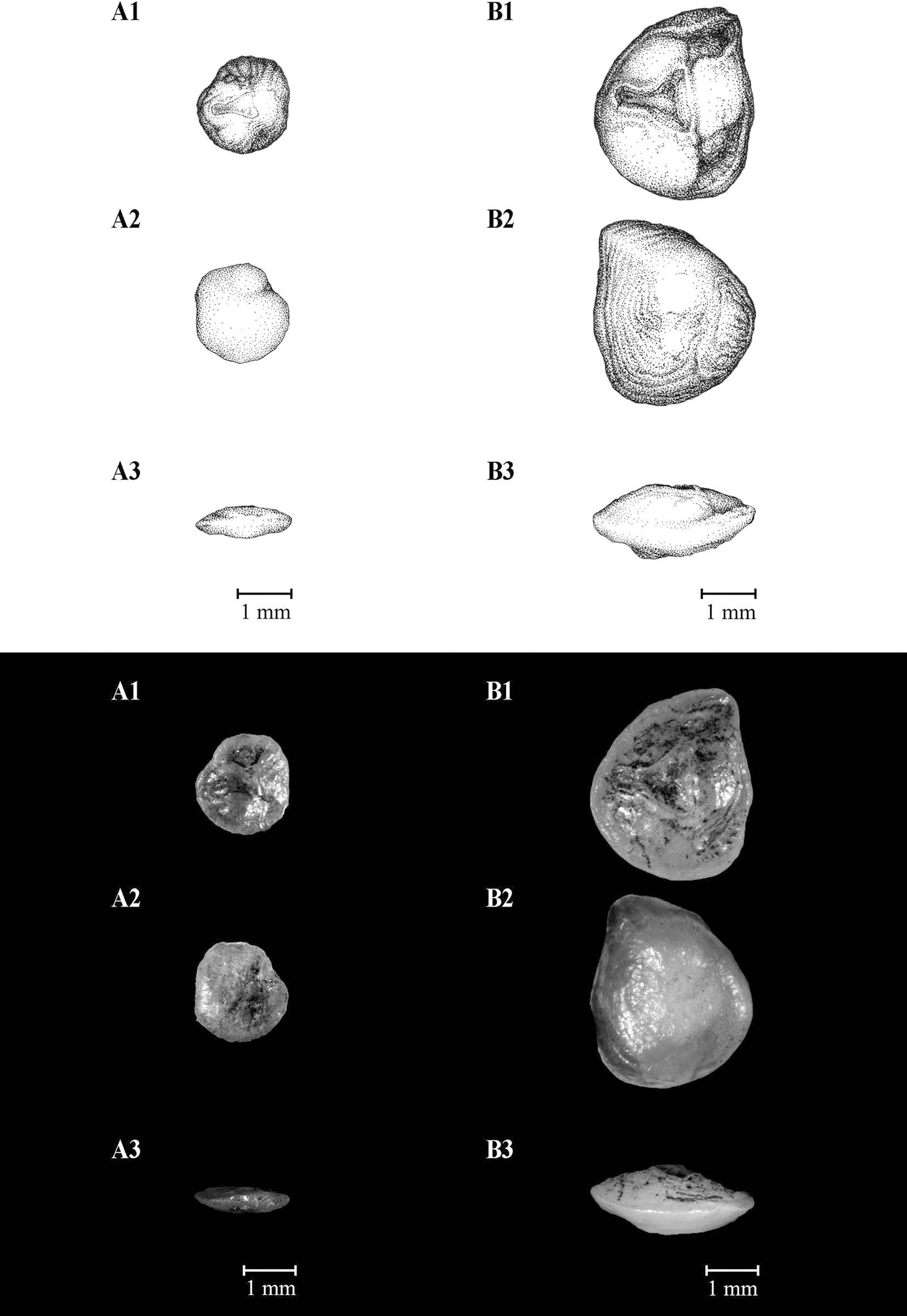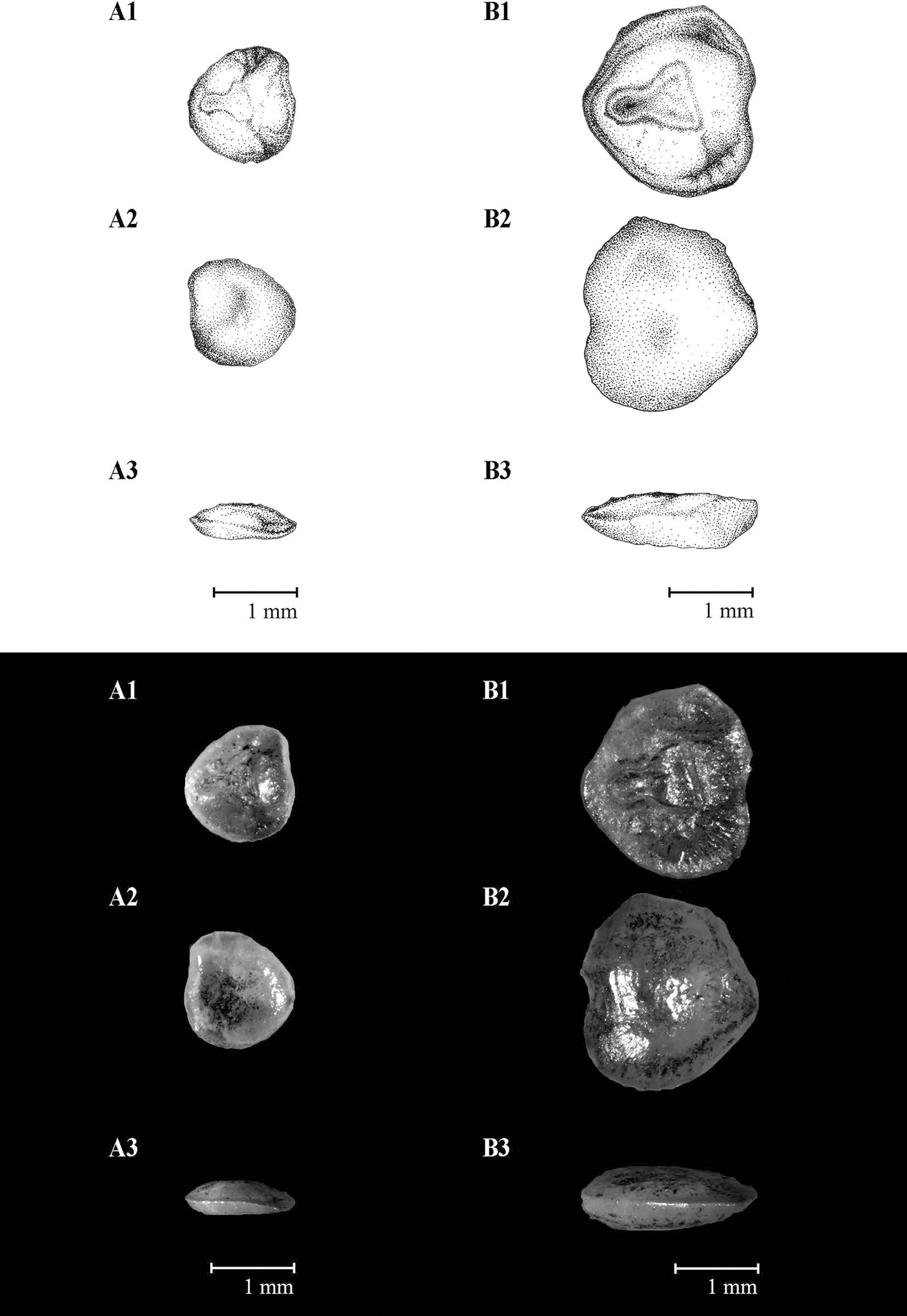Abstract
To complement the series of manuscripts published as "Atlas of Teleostei Otoliths of the Southeastern-Southern Brazil", in this volume we present results for species of Siluriformes (two species) and Pleuronectiformes (thirteen species) orders. Considering that the sagittae of Siluriformes are very small we analyzed the left lapillus. Due to the asymmetry of the Pleuronectiformes otoliths, were analysed both left and right structures, being the circumsulcal depression the most important feature to diagnose these species.
Descriptors:
Sagittae; Lapilli; Morphology; Morphometry; Siluriformes; Pleuronectiformes
Resumo
Em complemento à série de manuscritos publicados como "Atlas de Otólitos para os Teleósteos da região Sudeste-Sul do Brasil", neste volume apresentamos os resultados obtidos para espécies das ordens Siluriformes (duas espécies) e Pleuronectiformes (treze espécies). Tendo em vista que os sagittae dos Siluriformes são muito pequenos, foram analisados os lapilli esquerdos. Devido a assimetria dos Pleuronectiformes, foram analisados tanto sagittae esquerdos quanto direitos, sendo a depressão circumsulcal a feição mais importante para diagnosticar as espécies desta ordem.
Descritores:
Sagittae; Lapilli; Morfologia; Morfometria; Siluriformes; Pleuronectiformes
INTRODUCTION
The analysis of otolith shapes is widely applied in taxonomical, phylogenetical, paleontological and food web studies, as well as for the discrimination of populations and other intraspecific forms (FITCH; BROWNELL, 1968FITCH, J.E., BROWNELL, R. L. Fish otolith in cetacean stomachs and their Importance in interpreting feeding habits. J.Fish. Res. Bd. Canada, 25(12): 2561-2574, 1968.; CAMPANA, 2005CAMPANA, S. E. Otolith science enrering the 21st century. Marine and Freshwater Research, 56, 485-495, 2005.; & TUSSET et al, 2008). So, the use of the shape analysis to characterize otolith outlines has become a powerful tool with increasing popularity.
As a contribution for these and other studies, we have been improving the Collection of Teleostei Fish Otoliths of the Southeastern-Southern Brazil (COSS-Brasil) held at the Instituto Oceanográfico - USP, (IOUSP). Nowadays our collection contains around 52,000 pairs of otoliths related to 24 orders, 66 families and 202 species (ROSSI-WONGTSCHOWSKI et al., 2016ROSSI-WONGTSCHOWSKI, C. L. D. B.; CHALOM, A.; SILIPRANDI, C. C.; BRENHA-NUNES, M. R.; CONVERSANI, V. R. M.; SANTIFICETUR, C.; GIARETTA, M. B. COSS-Brasil: Coleção de Otólitos de Peixes Marinhos da Região Sudeste-Sul do Brasil. São Paulo: Instituto Oceanográfico da Universidade de São Paulo, 2016.). Also we have been developing a series of papers providing a permanent visual record of otoliths from the Southeastern-Southern Brazilian coast: ROSSI-WONGTSCHOWSKI et al. (2014)ROSSI-WONGTSCHOWSKI, C. L. D. B.; SILIPRANDI, C. C.; BRENHA, M. R.; GONSALES, S. A.; SANTIFICETUR. C.; VAZ-DOS-SANTOS, A. M. Atlas of marine bony fish otoliths (Sagittae) of Southeastern - Southern Brazil Part I: Gadiformes (Macrouridae, Moridae, Bregmacerotidae, Phycidae and Merlucciidae); Part II: Perciformes (Carangidae, Sciaenidae, Scombridae and Serranidae). Braz. J. Oceanogr., v. 62, n.spe. 1, p. 1-103, 2014., SILIPRANDI et al. (2016SILIPRANDI, C. C.; BRENHA-NUNES, M. R.; ROSSI-WONGTSCHOWSKI, C. L. D. B.; SANTIFICETUR, C. Atlas of marine bony fish otoliths (sagittae) of Southeastern-Southern Brazil Part III: Clupeiformes (Clupeidae, Engraulidae, Pristigasteridae). Braz. J. Oceanogr., v. 64, n.spe. 1, p. 1-22, 2016.), BRENHA-NUNES et al. (2016BRENHA-NUNES, M. R.; SANTIFICETUR, C.; CONVERSANI, V. R. M.; GIARETTA, M. B.; ROSSI-WONGTSCHOWSKI, C. L. D. B.; SILIPRANDI, C. C. Atlas of marine bony fish otoliths (sagittae) of Southeastern-Southern Brazil Part IV: Perciformes (Centropomidae, Acropomatidae, Serranidae, Priacanthidae, Malacanthidae, Pomatomidae, Carangidae, Lutjanidae, Gerreidae and Haemulidae). Braz. J. Oceanogr., v. 64, n.spe 1, p. 23-75, 2016.) and two other: SANTIFICETUR et al. 2017SANTIFICETUR, C.; CONVERSANI, V. R. M.; BRENHA-NUNES, R. B GIARETTA, M. B.; SILIPRANDI, C. C.; ROSSI-WONGTSCHOWSKI, C. L. D. B. Atlas of marine bony fish otoliths (sagittae) of Southeastern-Southern Brazil Part V: Perciformes (Sparidae, Scianidae, Polynemidae, Mullidae, Kyphosidae, Chaetodontidae, Mugilidae, Scaridae, Percophidae, Pinguipedidae, Blenniidae Gobiidae, Ephippidae, Sphyraenidae, Gempylidae, Trichiuridae, Scombridae, Ariommatidae, Stromateidae and Caproidae). Braz. J. Oceanogr, 65(2):201-257. 2017. and GIARETTA et al. 2017GIARETTA, M. B.; SILIPRANDI, C. C.; SANTIFICETUR, C.; BRENHA-NUNES, M. R.; CONVERSANI, V. R. M.; ROSSI-WONGTSCHOWSKI, C. L. D. B. Atlas of marine bony fish otolith (sagittae) of Southeastern-Southern Brazil Part VI: Albuliformes, Anguiliformes, Osmeriformes, Stomiiformes, Aulopiformes, Myctophiformes, Ophidiiformes, Polimixiiformes, Batrachoidiformes and Lophiformes. Braz. J. Oceanogr, 65(2):278-308. 2017. GIARETTA et al., 2017GIARETTA, M. B.; SILIPRANDI, C. C.; SANTIFICETUR, C.; BRENHA-NUNES, M. R.; CONVERSANI, V. R. M.; ROSSI-WONGTSCHOWSKI, C. L. D. B. Atlas of marine bony fish otolith (sagittae) of Southeastern-Southern Brazil Part VI: Albuliformes, Anguiliformes, Osmeriformes, Stomiiformes, Aulopiformes, Myctophiformes, Ophidiiformes, Polimixiiformes, Batrachoidiformes and Lophiformes. Braz. J. Oceanogr, 65(2):278-308. 2017. being this volume the last part of the series. Herein, we present the features, measurements and related shape indices of Siluriformes and Pleuronectiformes otoliths.
Usually, lapilli are small, regular-shaped, homogenous otoliths, however use is not common to diagnose most species. With the exception of the Siluriformes order, in which the sagittae are small and extremely fragile, the use of lapilli is more advantageous in the characterization of this group of fish because they are larger (ADAMS, 1940ADAMS, L. A. Some characteristic otoliths of American Ostariophysi. J. Morphol., v. 66, n. 3, p. 497-527, 1940.; MARTÌNEZ; MONASTERIO DE GONZO, 1991MARTINEZ, V.; MONASTERIO DE GONZO, G. Clave de identificación de algunos peces Siluriformes en base al estudio de sus otolitos. Rev. Asoc. Cienc. Nat. Litoral, v. 2, n. 22, p. 95-118, 1991.; ASSIS, 2005ASSIS, C. A. The utricular otoliths, lapilli, of teleosts: their morphology and relevance for species identification and systematics studies. Sci. Mar., v. 69, n. 2, p. 259-273, 2005.).
The order Pleuronectiformes includes the flatfishes that are symmetrical and planktonic in the larval phase. Throughout the development, these fish undergo a metamorphosis resulting in asymmetry of the eyes, nerves and muscles of the skull, teeth, scales, paired fins and lateral line. Therefore, due to this asymmetry, the left and right sagittae may be different (CAMPANA, 1984CAMPANA, S. E. Lunar cycles of otolith growth in the juvenile starry flounder Platichthys stellatus. Mar. BioI., v, 80, n. 3, p. 239-246, 1984.; VOLPEDO; ECHEVERRÍA, 1997VOLPEDO A. V.; ECHEVERRÍA D. D. Morfología de la sagitta de lenguados del Mar Argentino (Pisces: Pleuronectiformes). Thalassas, v. 13, p. 113-126, 1997.; LYCHAKOV et al., 2008LYCHAKOV, D. V.; REBANE, Y. T.; LOMBARTE, A.; DEMESTRE, M.; FUIMAN, L. A. Saccular otolith mass asymmetry in adult flatfishes. J. Fish Biol., v. 72, n. 10, p. 2579-2594, 2008) and in that case, it is important to characterize both. Considering that it is not usual to find results about the otolith pair of the flatfish we decided to present them in order to make easy the species diagnosis conducted in different areas especially in Paleontology.
We hope that our papers and our collection will provide a valuable legacy for all sort of studies involving otolith morphology.
MATERIAL AND METHODS
The characteristics of the study area and the general methodology applied to the sagittae classification are described in ROSSI-WONGTSCHOWSKI et al. (2014)ROSSI-WONGTSCHOWSKI, C. L. D. B.; SILIPRANDI, C. C.; BRENHA, M. R.; GONSALES, S. A.; SANTIFICETUR. C.; VAZ-DOS-SANTOS, A. M. Atlas of marine bony fish otoliths (Sagittae) of Southeastern - Southern Brazil Part I: Gadiformes (Macrouridae, Moridae, Bregmacerotidae, Phycidae and Merlucciidae); Part II: Perciformes (Carangidae, Sciaenidae, Scombridae and Serranidae). Braz. J. Oceanogr., v. 62, n.spe. 1, p. 1-103, 2014., SILIPRANDI et al. (2016)SILIPRANDI, C. C.; BRENHA-NUNES, M. R.; ROSSI-WONGTSCHOWSKI, C. L. D. B.; SANTIFICETUR, C. Atlas of marine bony fish otoliths (sagittae) of Southeastern-Southern Brazil Part III: Clupeiformes (Clupeidae, Engraulidae, Pristigasteridae). Braz. J. Oceanogr., v. 64, n.spe. 1, p. 1-22, 2016., BRENHA-NUNES et al. (2016)BRENHA-NUNES, M. R.; SANTIFICETUR, C.; CONVERSANI, V. R. M.; GIARETTA, M. B.; ROSSI-WONGTSCHOWSKI, C. L. D. B.; SILIPRANDI, C. C. Atlas of marine bony fish otoliths (sagittae) of Southeastern-Southern Brazil Part IV: Perciformes (Centropomidae, Acropomatidae, Serranidae, Priacanthidae, Malacanthidae, Pomatomidae, Carangidae, Lutjanidae, Gerreidae and Haemulidae). Braz. J. Oceanogr., v. 64, n.spe 1, p. 23-75, 2016.. Additionally, due to the Pleuronectiformes asymmetry, the circumsulcal depression feature were analyzed and a new classification were proposed (being complete or incomplete) (Figure 1).
Circumsulcal depression illustrated by the black area: A- Complete (Symphurus tessellatus); B- Incomplete (Paralichthys triocellatus). (Illustration: Alexandre Arackawa).
We analyzed the left lapillus of the Siluriformes following the terminology of ASSIS (2005)ASSIS, C. A. The utricular otoliths, lapilli, of teleosts: their morphology and relevance for species identification and systematics studies. Sci. Mar., v. 69, n. 2, p. 259-273, 2005., with modifications. The features adopted were: 1) otolith shape, 2) anterior region, 3) posterior region, 4) internal and external edges 5) otolith profile and, two more that are important for these order, 6) suculus lapilli and 7) incisura linea basalis. A new terminology was created for these last features being suculus lapilli: tubular strait and tubular curved (Figure 2) and the incisura linea basalis: absent, shallow, deep and deep bent (Figure 3).
Proposed terminology for the suculus lapilli (black area). A) Genidens genidens, B) Genidens barbus. (Illustration: Laura Montserrat).
Proposed terminology for the incisura linea basalis. A) Amphiarius rugispinis, B) Sciades herzbergii, C) and D) Bagreprotocaribbeanus sp. (Adapted from AGUILERA et al., 2013).
When available three otoliths of each species were illustrated and photographed. The frequency of occurrence of each characteristic was calculated by total length classes (TL), and differences within and among classes have been analyzed applying multiple χ2 test (significance 0.05).
The acronyms presented in the shape indices tables are: T=total fish length, OL=otolith length, OH=otolith height and OT=otolith thickness.
RESULTS
Order SILURIFORMES
Family ARIIDAE
Illustrations (above) and photographs (below) of Genidens barbus lapillus from fish with total length: A. 504 mm. The ventral face is shown in A1; the dorsal face in A2; and the medial face in A3; (Illustration: Laura Montserrat; Photos: Cesar Santificetur).
Shape: oval. Anterior region: oblique-round. Posterior region: round.Lateral edge: entire. Medial edge: entire. Profile: biconvex. Incisura linea basalis: absent. Sulculus lapilli: tubular curved.
Since only one lapillus was analyzed no statistical analysis were done, but its morphometric characteristics are shown below:
Illustrations (above) and photographs (below) of Genidens genidens lapillus from fish with total length: A. 241 mm. The ventral face is shown in A1; the dorsal face in A2; and the medial face in A3 (Illustration: Laura Montserrat; Photos: Cesar Santificetur).
Shape: oval. Anterior region: oblique-round. Posterior region: round. Lateral edge: entire. Medial edge: entire. Profile: biconvex. Incisura linea basalis: deep. Sulculus lapilli: tubular straight.
Since only one lapillus was analyzed no statistical analysis were done but its morphometric characteristics are shown below:
Order PLEURONECTIFORMES
Most of the Pleuronectiformes does not present rostrum and antirostrum so, in this paper these characteristics are described when present.
Family ACHIRIDAE
Illustrations (above) and photographs (below) of Achirus lineatus left sagitta from fish with total length: A. 151 mm. The medial face is shown in A1; the lateral face in A2; and the ventral profile in A3 (Illustration: Vanessa Seiko Sugihara; Photos: Cesar Santificetur).
Illustrations (above) and photographs (below) of Achirus lineatus right sagitta from fish with total length: A. 151 mm. The medial face is shown in A1; the lateral face in A2; and the ventral profile in A3 (Illustration: Vanessa Seiko Sugihara; Photos: Cesar Santificetur).
Left otolith
Shape: bullet-shape. Anterior region: round. Posterior region: flattened. Dorsal edge: sinuate. Ventral edge: sinuate. Profile: concave-convex. Sulcus acusticus: position: median; orientation: horizontal; opening: mesial; morphology: heterosulcoid; colliculum: heteromorphic; ostium: elliptic; cauda: round-oval. Circumsulcal depression: incomplete.
The small number of otoliths did not permit data statistical analysis; however its morphometric characteristics are shown below:
Right otolith
Shape: bullet-shape. Anterior region: round. Posterior region: flattened. Dorsal edge: sinuate. Ventral edge: sinuate.
Profile: concave-convex. Sulcus acusticus: position: median; orientation: horizontal; opening: mesial; morphology: heterosulcoid; colliculum: heteromorphic; ostium: elliptic; cauda: round-oval.Circumsulcal depression: incomplete.
The small number of otoliths did not permit data statistical analysis; however its morphometric characteristics are shown below:
Family PARALICHTHYIDAE
The ostium is frequently elliptic and the cauda morphology is round-oval in most otoliths. The circumsulcal depression is always incomplete and the pseudorostrum and pseudoantirostrum are always absent.
Illustrations (above) and photographs (below) of Citharichthys macrops left sagitta from fish with total length: A. 134 mm. The medial face is shown in A1; the lateral face in A2; and the ventral profile in A3 (Illustration: Michelle Konig; Photos: Cesar Santificetur).
Illustrations (above) and photographs (below) of Citharichthys macrops right sagitta from fish with total length: A. 134 mm. The medial face is shown in A1; the lateral face in A2; and the ventral profile in A3 (Illustration: Michelle Konig; Photos: Cesar Santificetur).
Left otolith
Shape: pentagonal (75%), bullet-shaped. Anterior region: blunt (63%), peaked-round. Posterior region: notched-round (50%), blunt, peaked-round. Anterior dorsal edge: entire (88%), lobed to sinuate. Dorsal edge: entire (50%), sinuate, does not apply.Anterior ventral edge: lobed (50%), entire, sinuate. Posterior ventral edge: sinuate (38%), lobed, does not apply.Posterior edge: entire (50%), does not apply, lobed, sinuate. Profile: concave-convex (75%), plane-convex. Sulcus acusticus: position: median; orientation: descending (63%), horizontal; opening: mesial; morphology: heterosulcoid; colliculum: heteromorphic; ostium: elliptic (88%), oval; cauda: round-oval (88%), elliptic. Circumsulcal depression: incomplete.
The small number of otoliths did not permit data statistical analysis; however its morphometric characteristics are shown below:
Right otolith
Shape: pentagonal (86%), oval. Anterior region: peaked-round. Posterior region: notched-round (57%), blunt, flattened, round. Anterior dorsal edge: entire (86%), sinuate. Dorsal edge: sinuate (43%), lobed, entire, does not apply. Anterior ventral edge: entire. Posterior ventral edge: entire (71%), sinuate, does not apply. Posterior edge: entire (71%), sinuate, does not apply. Profile: concave-convex (86%), biconvex. Sulcus acusticus: position: median; orientation: descending (86%), horizontal; opening: mesial; morphology: heterosulcoid; colliculum: heteromorphic; ostium: oval (57%), elliptic; cauda: elliptic (57%), round-oval.Circumsulcal depression: incomplete.
The small number of otoliths did not permit data statistical analysis; however its morphometric characteristics are shown below:
Illustrations (above) and photographs (below) of Citharichthys spilopterus left sagittae from fish with total length: A. 63 mm; B. 183 mm. The medial face is shown in A1; B1; the lateral face in A2; B2; and the ventral profile in A3; B3 (Illustration: Michelle Konig; Photos: Cesar Santificetur).
Illustrations (above) and photographs (below) of Citharichthys spilopterus right sagittae from fish with total length: A. 63 mm; B. 183 mm. The medial face is shown in A1; B1; the lateral face in A2; B2; and the ventral profile in A3; B3 (Illustration: Michelle Konig; Photos: Cesar Santificetur).
Left otolith
Shape: pentagonal. Anterior region: peaked. Posterior region: oblique (57%), blunt, flattened. Anterior dorsal edge: entire. Dorsal edge: entire (97%), sinuate. Anterior ventral edge: entire. Posterior ventral edge: entire. Posterior edge: entire. Profile: concave-convex.Sulcus acusticus: position: median; orientation: descending (95%), horizontal; opening: mesial; morphology: pseudo-archaesulcoid; colliculum: heteromorphic; ostium: elliptic; cauda: round-oval. Circumsulcal depression: incomplete.
Statistical differences (p<0.05) within some length classes were obtained for posterior dorsal edge and sulcus acusticus orientation. No differences were found along the fish growth.
Right otolith
Shape: pentagonal. Anterior region: peaked. Posterior region: blunt (80%), flattened. Anterior dorsal edge: entire. Posterior dorsal edge: entire (94%), lobed. Anterior ventral edge: entire. Dorsal edge: entire. Posterior edge: entire (94%), sinuate. Profile: concave-convex.Sulcus acusticus: position: median; orientation: descending; opening: mesial; morphology: pseudo-archaesulcoid; colliculum: heteromorphic; ostium: elliptic; cauda: round-oval. Circumsulcal depression: incomplete.
Statistical differences (p<0.05) within some length classes were obtained for posterior dorsal and posterior edges and posterior region. No differences were found along the fish growth.
Illustrations (above) and photographs (below) of Etropus crossotus left sagittae from fish with total length: A. 50 mm; B. 109 mm; C. 157 mm. The medial face is shown in A1; B1; C1; the lateral face in A2; B2; C2; and the ventral profile in A3; B3; C3 (Illustration: Michelle Konig; Photos: Cesar Santificetur).
Illustrations (above) and photographs (below) of Etropus crossotus right sagittae from fish with total length: A. 50 mm; B. 109 mm; C. 157 mm. The medial face is shown in A1; B1; C1; the lateral face in A2; B2; C2; and the ventral profile in A3; B3; C3 (Illustration: Michelle Konig; Photos: Cesar Santificetur).
Left otolith
Shape: pentagonal. Anterior region: peaked. Posterior region: oblique (57%), blunt, flattened. Anterior dorsal edge: entire. Dorsal edge: entire (97%), sinuate. Anterior ventral edge: entire. Posterior ventral edge: entire. Posterior edge: entire. Profile: concave-convex.Sulcus acusticus: position: median; orientation: descending (95%), horizontal; opening: mesial; morphology: pseudo-archaesulcoid; colliculum: heteromorphic; ostium: elliptic; cauda: round-oval. Circumsulcal depression: incomplete.
Statistical differences (p<0.05) within some length classes were obtained for shape, anterior and posterior region, posterior ventral, ventral, posterior, dorsal posterior and dorsal edges, sulcus acusticus orientation and morphology, colliculum, ostium and cauda morphology. Along the fish growth statistical differences were found for ventral and posterior dorsal edge.
Right otolith
Shape: pentagonal. Anterior region: peaked. Posterior region: oblique (57%), blunt, flattened. Anterior dorsal edge: entire. Dorsal edge: entire (97%), sinuate. Anterior ventral edge: entire. Posterior ventral edge: entire. Posterior edge: entire. Profile: concave-convex. Sulcus acusticus: position: median; orientation: descending (95%), horizontal; opening: mesial; morphology: pseudo-archaesulcoid; colliculum: heteromorphic; ostium: elliptic; cauda: round-oval.Circumsulcal depression: incomplete.
Statistical differences (p<0.05) within some length classes were obtained for posterior region, posterior ventral and ventral edges, and sulcus acusticus orientation. Along the fish growth statistical differences were found only for ventral edge.
Illustrations (above) and photographs (below) of Etropus longimanus left sagittae from fish with total length: A. 53 mm; B. 98 mm; C. 145 mm. The medial face is shown in A1; B1; C1; the lateral face in A2; B2; C2; and the ventral profile in A3; B3; C3 (Illustration: Michelle Konig; Photos: Cesar Santificetur).
Illustrations (above) and photographs (below) of Etropus longimanus right sagittae from fish with total length: A. 53 mm; B. 98 mm; C. 145 mm. The medial face is shown in A1; B1; C1; the lateral face in A2; B2; C2; and the ventral profile in A3; B3; C3 (Illustration: Michelle Konig; Photos: Cesar Santificetur).
Left otolith
Shape: pentagonal. Anterior region: peaked (70%), peaked-round. Posterior region: flattened (66%), blunt, oblique. Anterior dorsal edge: entire. Dorsal edge: entire (84%), sinuate, lobed to sinuate. Anterior ventral edge: entire (95%), sinuate. Posterior ventral edge: entire (91%), sinuate. Posterior edge: entire (95%), sinuate. Profile: plane-convex. Sulcus acusticus: position: median; orientation: horizontal (77%), descending; opening: mesial; morphology: archaesulcoid (73%), pseudo-archaesulcoid; colliculum: homomorphic (73%), heteromorphic; ostium: absent (73%), elliptic; cauda: absent (73%), round-oval. Circumsulcal depression: incomplete.
Statistical differences (p<0.05) within some length classes were obtained for posterior region, posterior ventral, ventral, posterior dorsal and posterior edges, sulcus acusticus orientation and morphology, colliculum, ostium and cauda morphology. Along the fish growth statistical differences were found for sulcus acusticus morphology, colliculum and cauda morphology.
Right otolith
Shape: pentagonal (70%), oval. Anterior region: peaked (82%), peaked-round. Posterior region: flattened (64%), round, blunt, oblique. Anterior dorsal edge: entire (95%), lobed. Dorsal edge: entire (50%), does not apply, lobed, sinuate. Anterior ventral edge: entire. Posterior ventral edge: entire (66%), does not apply, sinuate. Posterior edge: entire (59%), does not apply, sinuate, lobed. Profile: plane-convex. Sulcus acusticus: position: median; orientation: horizontal (70%), descending; opening: mesial; morphology: archaesulcoid; colliculum: monomorphic; ostium: absent; cauda: absent.Circumsulcal depression: incomplete.
Statistical differences (p<0.05) within some length classes were obtained for shape, anterior and posterior region, posterior ventral, posterior, dorsal and posterior dorsal edges and sulcus acusticus orientation. Along the fish growth statistical differences were found only for sulcus acusticus orientation.
Illustrations (above) and photographs (below) of Paralichthys isosceles left sagittae from fish with total length: A. 197 mm; B. 287 mm; C. 377 mm. The medial face is shown in A1; B1; C1; the lateral face in A2; B2; C2; and the ventral profile in A3; B3; C3 (Illustration: Michelle Konig; Photos: Cesar Santificetur).
Illustrations (above) and photographs (below) of Paralichthys isosceles right sagittae from fish with total length: A. 197 mm; B. 287 mm; C. 377 mm. The medial face is shown in A1; B1; C1; the lateral face in A2; B2; C2; and the ventral profile in A3; B3; C3 (Illustration: Michelle Konig; Photos: Cesar Santificetur).
Left otolith
Shape: elliptic (75%), oval. Anterior region: round (82%), peaked-round, peaked. Posterior region: round. Dorsal edge: sinuate (62%), entire. Ventral edge: entire (74%), sinuate. Profile: biconvex (56%), flattened, plane-convex. Sulcus acusticus: position: median; orientation: horizontal (89%), ascending; opening: mesial; morphology: heterosulcoid; colliculum: heteromorphic; ostium: tubular; cauda: round-oval. Circumsulcal depression: incomplete.
Statistical differences (p<0.05) within some length classes were obtained for shape, anterior region, ventral and dorsal edges, profile and sulcus acusticus orientation. Along the fish growth statistical differences were found only for profile.
Right otolith
Shape: oval (38%), elliptic (33%), rectangular to elliptic (29%). Anterior region: round (53%), peaked-round, round. Posterior region: round. Dorsal edge: entire (67%), sinuate. Ventral edge: entire (86%), sinuate. Anterior edge: does not apply (71%), entire. Posterior edge: does not apply (75%), entire. Profile: pane-convex (67%), concave-convex. Sulcus acusticus: position: median; orientation: horizontal (60%), ascending; opening: mesial (92%), para-ostial, ostial; morphology: heterosulcoid; colliculum: heteromorphic; ostium: elliptic; cauda: round-oval. Circumsulcal depression: incomplete.
Statistical differences (p<0.05) within some length classes were obtained for shape, anterior region, posterior, ventral, dorsal and anterior edges, profile and sulcus acusticus orientation and opening. Along the fish growth statistical differences were found for shape, posterior and dorsal edges and sulcus acusticus orientation.
Illustrations (above) and photographs (below) of Paralichthys patagonicus left sagittae from fish with total length: A. 125 mm; B. 323 mm; C. 555 mm. The medial face is shown in A1; B1; C1; the lateral face in A2; B2; C2; and the ventral profile in A3; B3; C3 (Illustration: Michelle Konig; Photos: Cesar Santificetur).
Illustrations (above) and photographs (below) of Paralichthys patagonicus right sagittae from fish with total length: A. 125 mm; B. 323 mm; C. 555 mm. The medial face is shown in A1; B1; C1; the lateral face in A2; B2; C2; and the ventral profile in A3; B3; C3 (Illustration: Michelle Konig; Photos: Cesar Santificetur).
Left otolith
Shape: elliptic (74%), oval. Anterior region: peaked-round (77%), peaked, round, double-peaked. Posterior region: round (82%), flattened. Dorsal edge: sinuate (79%), lobed, entire. Ventral edge: sinuate (47%), entire (39%), lobed, lobed to sinuate. Profile: concave-convex (92%), biconvex, flattened. Rostrum and antirostrum orientation: does not apply. Rostrum: developed (99%), absent. Antirostrum: absent (99%), underdeveloped. Sulcus acusticus: position: median; orientation: horizontal (98%), ascending; opening: ostial (66%), para-ostial; morphology: heterosulcoid; colliculum: heteromorphic; ostium: elliptic (93%), funnel-like; cauda: round-oval.Circumsulcal depression: incomplete.
Statistical differences (p<0.05) within some length classes were obtained for shape, anterior and posterior region, ventral and dorsal edges, profile, sulcus acusticus orientation and opening, rostrum development and ostium morphology. No differences were found along the fish growth.
Right otolith
Shape: elliptic (73%), oval. Anterior region: peaked-round (77%), peaked, round, angled. Posterior region: round (88%), flattened, oblique. Dorsal edge: sinuate (62%), entire, lobed. Ventral edge: entire (51%), sinuate, lobed. Profile: concave-convex (98%), biconvex. Rostrum and antirostrum orientation: does not apply (89%), in agreement. Rostrum: developed (99%), absent. Antirostrum: absent (88%), underdeveloped, developed. Sulcus acusticus: position: median; orientation: horizontal (99%), ascending; opening: ostial (67%), para-ostial; morphology: heterosulcoid; colliculum: heteromorphic; ostium: elliptic (92%), funnel-like; cauda: round-oval. Circumsulcal depression: incomplete.
Statistical differences (p<0.05) within some length classes were obtained for shape, anterior and posterior region, ventral and dorsal edges, profile, sulcus acusticus orientation and opening, rostrum and antirostrum orientation and development and ostium morphology. Along the fish growth statistical differences were found for shape, dorsal edges.
Illustrations (above) and photographs (below) of Paralichthys triocellatus left sagittae from fish with total length: A. 70 mm; B. 205 mm; C. 338 mm. The medial face is shown in A1; B1; C1; the lateral face in A2; B2; C2; and the ventral profile in A3; B3; C3 (Illustration: Michelle Konig; Photos: Cesar Santificetur).
Illustrations (above) and photographs (below) of Paralichthys triocellatus right sagittae from fish with total length: A. 70 mm; B. 205 mm; C. 338 mm. The medial face is shown in A1; B1; C1; the lateral face in A2; B2; C2; and the ventral profile in A3; B3; C3 (Illustration: Michelle Konig; Photos: Cesar Santificetur).
Left otolith
Shape: elliptic (78%), oval. Anterior region: round (55%), peaked-round. Posterior region: round (88%), flattened, angled-round. Dorsal edge: sinuate (80%), entire. Ventral edge: entire (57%), sinuate. Profile: biconvex (64%), concave-convex, plane-convex. Rostrum and antirostrum orientation: does not apply. Rostrum: absent (75%), developed, underdeveloped. Antirostrum: absent. Sulcus acusticus: position: median; orientation; horizontal (91%), ascending; opening: pseudo-ostial (43%), mesial, para-ostial, ostial; morphology: heterosulcoid; colliculum: heteromorphic; ostium: elliptic (87%), funnel-like, rectangular; cauda: round-oval. Circumsulcal depression: incomplete.
Statistical differences (p<0.05) within some length classes were obtained for shape, anterior and posterior region, dorsal edges, profile, sulcus acusticus orientation and opening, rostrum development and ostium morphology. Along the fish growth statistical differences were found for anterior region, profile and sulcus acusticus opening.
Right otolith
Shape: oval (68%), elliptic. Anterior region: round (67%), peaked, oblique, angled. Posterior region: round.Dorsal edge: entire (80%), sinuate. Ventral edge: entire (90%), sinuate, lobed. Profile: biconvex (64%), concave-convex, plane-convex. Rostrum and antirostrum orientation: does not apply (96%), in agreement. Rostrum: absent (54%), developed, underdeveloped. Antirostrum: absent (96%), developed. Sulcus acusticus: position: median; orientation: horizontal; opening: ostial (67%), mesial, para-ostial; morphology: heterosulcoid; colliculum: heteromorphic; ostium: elliptic (87%), funnel-like, rectangular; cauda: round-oval.Circumsulcal depression: incomplete.
Statistical differences (p<0.05) within some length classes were obtained for shape, anterior region, ventral and dorsal edges, profile, sulcus acusticus opening, rostrum and antirostrum development and ostium morphology. Along the fish growth statistical differences were found for shape, anterior region and profile and rostrum development.
Illustrations (above) and photographs (below) of Syacium papillosum left sagittae from fish with total length: A. 60 mm; B. 162 mm; C. 275 mm. The medial face is shown in A1; B1; C1; the lateral face in A2; B2; C2; and the ventral profile in A3; B3; C3 (Illustration: Michelle Konig; Photos: Cesar Santificetur).
Illustrations (above) and photographs (below) of Syacium papillosum right sagittae from fish with total length: A. 60 mm; B. 162 mm; C. 275 mm. The medial face is shown in A1; B1; C1; the lateral face in A2; B2; C2; and the ventral profile in A3; B3; C3 (Illustration: Michelle Konig; Photos: Cesar Santificetur).
Left otolith
Shape: bullet-shaped. Anterior region: oblique-round. Posterior region: flattened (60%), blunt, oblique, round. Dorsal edge: entire (74%), sinuate, sinuate to entire, lobed to sinuate. Ventral edge: lobed to sinuate (74%), sinuate to entire, dentate to lobed. Posterior edge: lobed to sinuate (65%), entire. Profile: concave-convex. Sulcus acusticus: position: median; orientation: ascending; opening: mesial; morphology: heterosulcoid; colliculum: heteromorphic; ostium: elliptic; cauda: straight tubular (98%), round-oval.Circumsulcal depression: incomplete.
Statistical differences (p<0.05) within some length classes were obtained for posterior region, dorsal, ventral and posterior edges, cauda morphology. No differences were found along the fish growth.
Right otolith
Shape: bullet-shaped. Anterior region: oblique-round. Posterior region: flattened (71%), blunt. Dorsal edge: entire (45%), lobed to sinuate, lobed, sinuate. Ventral edge: lobed to sinuate (64%), entire, sinuate, sinuate to entire. Posterior edge: lobed to sinuate (76%), entire. Profile: concave-convex. Sulcus acusticus: position: median; orientation: ascending; opening: mesial; morphology: heterosulcoid; colliculum: heteromorphic; ostium: elliptic; cauda: straight tubular (98%), round-oval.Circumsulcal depression: incomplete.
Statistical differences (p<0.05) within some length classes were obtained for posterior region, dorsal, ventral and posterior edges, cauda morphology. Along the fish growth statistical differences were found only for dorsal edge.
Illustrations (above) and photographs (below) of Xystreurys rasile left sagittae from fish with total length: A. 76 mm; B. 248 mm; C. 392 mm. The medial face is shown in A1; B1; C1; the lateral face in A2; B2; C2; and the ventral profile in A3; B3; C3 (Illustration: Michelle Konig; Photos: Cesar Santificetur).
Illustrations (above) and photographs (below) of Xystreurys rasile right sagittae from fish with total length: A. 76 mm; B. 248 mm; C. 392 mm. The medial face is shown in A1; B1; C1; the lateral face in A2; B2; C2; and the ventral profile in A3; B3; C3 (Illustration: Michelle Konig; Photos: Cesar Santificetur).
Left otolith
Shape: trapezoidal to elliptic (52%), elliptic (48%). Anterior region: peaked-round (84%), peaked, oblique. Posterior region: round (33%), flattened (32%), angled (29%), oblique. Dorsal edge: sinuate (94%), entire. Ventral edge: entire (51%), sinuate (49%). Profile: concave-convex (88%), plane-convex. Rostrum and antirostrum orientation: does not apply. Rostrum: absent (96%), developed. Antirostrum: absent. Sulcus acusticus: position: median; orientation: horizontal (93%), ascending; opening: mesial (93%), para-ostial, pseudo-ostial; morphology: pseudo-archaesulcoid; colliculum: heteromorphic; ostium: elliptic; cauda: round-oval. Circumsulcal depression: incomplete.
Statistical differences (p<0.05) within some length classes were obtained shape, anterior and posterior region, dorsal, ventral and edges, profile, sulcus acusticus orientation and opening and rostrum development. Along the fish growth statistical differences were found for posterior region, ventral edge and profile.
Right otolith
Shape: elliptic (74%), trapezoidal to elliptic. Anterior region: peaked-round (89%), peaked, round. Posterior region: round (54%), angled, flattened, peaked-round. Dorsal edge: sinuate (75%), entire. Ventral edge: entire (60%), sinuate, lobed. Profile: concave-convex (88%), plane-convex. Rostrum and antirostrum orientation: does not apply. Rostrum: absent. Antirostrum: absent. Sulcus acusticus: position: median; orientation: horizontal (99%), ascending; opening: mesial (93%), pseudo-ostial; morphology: pseudo-archaesulcoid; colliculum: heteromorphic; ostium: elliptic; cauda: round-oval. Circumsulcal depression: incomplete.
Statistical differences (p<0.05) within some length classes were obtained shape, anterior and posterior region, dorsal, ventral and edges, profile and sulcus acusticus orientation and opening. Along the fish growth statistical differences were found for ventral edge and profile.
Family CYNOGLOSSIDAE
The otolith shape is frequently discoidal or tall. The anterior region is round and the posterior one flattened. The ostium and cauda are always round-oval. The rostrum, antirostrum, pseudorstrum and pseudoantirostrum are absent and the circumsulcal depression is always complete. The right otolith tends to be larger than the left.
Illustrations (above) and photographs (below) of Symphurus tessellatus left sagittae from fish with total length: A. 137 mm; B. 218 mm. The medial face is shown in A1; B1; the lateral face in A2; B2; and the ventral profile in A3; B3 (Illustration: Alexandre Arackawa; Photos: Cesar Santificetur).
Illustrations (above) and photographs (below) of Symphurus tessellatus right sagittae from fish with total length: A. 137 mm; B. 218 mm. The medial face is shown in A1; B1; the lateral face in A2; B2; and the ventral profile in A3; B3 (Illustration: Alexandre Arackawa; Photos: Cesar Santificetur).
Left otolith
Shape: discoidal. Anterior region: round (75%), angled-round. Posterior region: round (75%), flattened. Dorsal edge: entire (88%), sinuate to entire. Ventral edge: entire (75%), sinuate to entire. Profile: plane-convex. Sulcus acusticus: position: median; orientation: descending; opening: mesial; morphology: heterosulcoid; colliculum: heteromorphic; ostium: round-oval; cauda: round-oval.Circumsulcal depression: complete.
The small number of otoliths did not permit data statistical analysis; however its morphometric characteristics are shown below:
Right otolith
Shape: discoidal. Anterior region: round. Posterior region: flattened. Dorsal edge: entire (78%), sinuate. Ventral edge: entire (78%), sinuate. Profile: plane-convex. Sulcus acusticus: position: median; orientation: horizontal; opening: mesial; morphology: heterosulcoid; colliculum: heteromorphic; ostium: round-oval; cauda: round-oval. Circumsulcal depression: complete.
The small number of otoliths did not permit data statistical analysis; however its morphometric characteristics are shown below:
Illustrations (above) and photographs (below) of Symphurus jenynsi left sagittae from fish with total length: A. 128 mm; B. 231 mm. The medial face is shown in A1; B1; the lateral face in A2; B2; and the ventral profile in A3; B3 (Illustration: Alexandre Arackawa; Photos: Cesar Santificetur).
Illustrations (above) and photographs (below) of Symphurus jenynsi right sagittae from fish with total length: A. 128 mm; B. 231 mm. The medial face is shown in A1; B1; the lateral face in A2; B2; and the ventral profile in A3; B3 (Illustration: Alexandre Arackawa; Photos: Cesar Santificetur)
Left otolith
Shape: tall. Anterior region: round. Posterior region: flattened. Dorsal edge: entire. Ventral edge: entire. Profile: plane-convex.Sulcus acusticus: position: median; orientation: horizontal; opening: mesial; morphology: heterosulcoid; colliculum: heteromorphic; ostium: round-oval; cauda: round-oval. Circumsulcal depression: complete.
The small number of otoliths did not permit data statistical analysis; however its morphometric characteristics are shown below:
Right otolith
Shape: tall (92%), discoidal. Anterior region: round. Posterior region: flattened. Dorsal edge: entire. Ventral edge: entire. Profile: biconvex.Sulcus acusticus: position: median; orientation: horizontal; opening: mesial; morphology: heterosulcoid; colliculum: heteromorphic; ostium: round-oval; cauda: round-oval. Circumsulcal depression: complete.
The small number of otoliths did not permit data statistical analysis; however its morphometric characteristics are shown below:
Illustrations (above) and photographs (below) of Symphurus plagusia left sagittae from fish with total length: A. 113 mm; B. 204 mm. The medial face is shown in A1; B1; the lateral face in A2; B2; and the ventral profile in A3; B3 (Illustration: Alexandre Arackawa; Photos: Cesar Santificetur).
Illustrations (above) and photographs (below) of Symphurus plagusia right sagittae from fish with total length: A. 113 mm; B. 204 mm. The medial face is shown in A1; B1; the lateral face in A2; B2; and the ventral profile in A3; B3 (Illustration: Alexandre Arackawa; Photos: Cesar Santificetur).
Left otolith
Shape: discoidal. Anterior region: round (96%), peaked. Posterior region: flattened. Dorsal edge: entire. Ventral edge: entire. Profile: plane-convex.Sulcus acusticus: position: median; orientation: horizontal; opening: mesial; morphology: heterosulcoid; colliculum: heteromorphic; ostium: round-oval; cauda: round-oval. Circumsulcal depression: complete.
Statistical differences (p<0.05) within some length classes were obtained for anterior region. No differences were found along the fish growth.
Right otolith
Shape: discoidal (84%), tall, triangular. Anterior region: round (96%), peaked. Posterior region: flattened (56%), round (44%). Dorsal edge: entire. Ventral edge: entire. Profile: biconvex (96%), plane-convex. Sulcus acusticus: position: median; orientation: horizontal; opening: mesial; morphology: heterosulcoid; colliculum: heteromorphic; ostium: round-oval; cauda: round-oval. Circumsulcal depression: complete.
Statistical differences (p<0.05) within some length classes were obtained for shape, anterior and posterior regions and profile. No differences were found along the fish growth.
ACKNOWLEDGMENTS
We thank: Nicolas Nathan dos Santos for some otoliths measurements and Alexandre Arackawa, Laura Montserrat, Michelle Koing and Vanessa Seiko Sugihara for the otoliths drawings. This paper received substantial financial support from the Fundação de Amparo à Pesquisa do Estado de São Paulo (FAPESP, Process number- 2010/51631-2 and 2014/03764-4).
Special thanks to Dr. Carlos A. Assis for his valuable comments, which greatly improved this paper.
REFERENCES
- ADAMS, L. A. Some characteristic otoliths of American Ostariophysi. J. Morphol., v. 66, n. 3, p. 497-527, 1940.
- AGUILERA, O. A; MORAES-SANTOS, H.; COSTA, S.; OHE, F.; JARAMILLO, C.; NOGUEIRA, A. Ariid sea catfish from the coeval Pirabas (Northeastern Brazil), Cantaure, Castillo (Northwestern Venezuela) and Castilletes (North Colombia) formations (Early Miocene), with description of three new species. Swiss J. Palaeontol., v. 132, n. 1, p. 45-68, 2013.
- ASSIS, C. A. The utricular otoliths, lapilli, of teleosts: their morphology and relevance for species identification and systematics studies. Sci. Mar., v. 69, n. 2, p. 259-273, 2005.
- BERNARDES, R. A.; FIGUEIREDO, J. L.; RODRIGUES, A. R.; FISHER, L. G.; VOOREN, C. M.; HAIMOVICI, M.; ROSSI-WONGTSCHOWSKI, C. L. D. B. Peixes da Zona Econômica Exclusiva da região Sudeste-Sul do Brasil: levantamento com armadilhas, pargueiras e rede de arrasto de fundo São Paulo: EDUSP, 2005. 295 p.
- BRENHA-NUNES, M. R.; SANTIFICETUR, C.; CONVERSANI, V. R. M.; GIARETTA, M. B.; ROSSI-WONGTSCHOWSKI, C. L. D. B.; SILIPRANDI, C. C. Atlas of marine bony fish otoliths (sagittae) of Southeastern-Southern Brazil Part IV: Perciformes (Centropomidae, Acropomatidae, Serranidae, Priacanthidae, Malacanthidae, Pomatomidae, Carangidae, Lutjanidae, Gerreidae and Haemulidae). Braz. J. Oceanogr., v. 64, n.spe 1, p. 23-75, 2016.
- CAMPANA, S. E. Lunar cycles of otolith growth in the juvenile starry flounder Platichthys stellatus. Mar. BioI., v, 80, n. 3, p. 239-246, 1984.
- CAMPANA, S. E. Otolith science enrering the 21st century. Marine and Freshwater Research, 56, 485-495, 2005.
- CARVALHO FILHO, A. Peixes: costa brasileira. São Paulo, Marca D’Água. 304 p. 1992.
- CERVIGÓN, F.; CIPRIANI, R.; FISCHER, W.; GARIBALDI, L.; HENDRICKX, M.; LEMUS, A. J.; MÁRQUEZ, R.; POUTIERS, J. M.; ROBAINA, G.; RODRIGUEZ, B. Fichas FAO de identificación de especies para los fines de la pesca: guía de campo de las especies comerciales marinas y de aquas salobres de la costa septentrional de Sur América Rome: FAO, 1992. 513 p.
- ESPÍRITO SANTO, R.V.; ISSAC, V. J.; SILVA, L. M. A.; MARTINELLI, J. M.; HIGUCHI, H.; SAINT-PAUL, U. Peixes e camarões do estuário do litoral de bragantino, Pará, Brasil Belém: MADAM, 2005. 268 p.
- FIGUEIREDO, J. L.; MENEZES, N. A. Manual de peixes marinhos do Sudeste do Brasil. II. Teleostei (1) São Paulo: Museu de Zoologia da Universidade de São Paulo, 1978. 110 p.
- FIGUEIREDO, J. L.; MENEZES, N. A. Manual de peixes marinhos do Sudeste do Brasil. VI. Teleostei (5) São Paulo: Museu de Zoologia da Universidade de São Paulo, 2000. 116 p.
- FIGUEIREDO, J. L.; SANTOS, A. P.; YAMAGUTI, N.; BERNARDES, R. A.; ROSSI-WONGTSCHOWSKI, C. L. D. B. Peixes da zona econômica exclusiva da região sudeste-sul do Brasil: Levantamento com rede de meia-água São Paulo: EDUSP, 2002. 242 p.
- FISCHER, L. G.; PEREIRA, L. E. D.; VIEIRA, J. P. Peixes estuarinos e costeiros. Série Biodiversidade do Atlântico Sudoeste Rio Grande: Ecoscientia, 2011. 46 p.
- FITCH, J.E., BROWNELL, R. L. Fish otolith in cetacean stomachs and their Importance in interpreting feeding habits. J.Fish. Res Bd. Canada, 25(12): 2561-2574, 1968.
- FROESE, R.; PAULY. D. FishBase. World Wide Web electronic publication Available: <http://www.fishbase.org>. Version: 01/2016.
» http://www.fishbase.org - GIARETTA, M. B.; SILIPRANDI, C. C.; SANTIFICETUR, C.; BRENHA-NUNES, M. R.; CONVERSANI, V. R. M.; ROSSI-WONGTSCHOWSKI, C. L. D. B. Atlas of marine bony fish otolith (sagittae) of Southeastern-Southern Brazil Part VI: Albuliformes, Anguiliformes, Osmeriformes, Stomiiformes, Aulopiformes, Myctophiformes, Ophidiiformes, Polimixiiformes, Batrachoidiformes and Lophiformes. Braz. J. Oceanogr, 65(2):278-308. 2017.
- HAIMOVICI, M.; MARTINS, A. S.; FIGUEIREDO, J. L.; VIEIRA, P. C. Demersal bony fish of the outer shelf and upper slope of the southern Brazil Subtropical Convergence Ecosystem. Mar. Ecol. Prog. Ser., v. 108, p. 59-77, 1994.
- HENSLEY, D. A. Paralichthyidae. Lenguados. In: FISCHER, W.; KRUPP, F.; SCHNEIDER, W.; SOMMER, C.; CARPENTER, K. E.; NIEM, V. (Eds.). Guia FAO para Identification de Especies para lo Fines de la Pesca Pacifico Centro-Oriental. 3 Vols. Rome: FAO, 1995. p. 1349-1380.
- KEITH, P.; LE BAIL, P. Y.; PLANQUETTE, P. Atlas des poissons d’eau douce de Guyane. Tome 2, Fascicule I: Batrachoidiformes, Mugiliformes, Beloniformes, Cyprinodontiformes, Synbranchiformes, Perciformes, Pleuronectiformes, Tetraodontiformes Collection Patrimoines Naturels. Paris: Publications scientifiques du Muséum national d’Histoire naturelle, 2000. 286 p.
- LESLIE JR, A. J.; STEWART, D. J. Systematics and Distributional Ecology of Etropus (Pisces, Bothidae) on the Atlantic Coast of the United States with Description of a New Species. Copeia, v. 1986, n. 1, p. 140-156, 1986.
- LYCHAKOV, D. V.; REBANE, Y. T.; LOMBARTE, A.; DEMESTRE, M.; FUIMAN, L. A. Saccular otolith mass asymmetry in adult flatfishes. J. Fish Biol., v. 72, n. 10, p. 2579-2594, 2008
- MARCENIUK, A. P.; FERRARIS JR, C. J. Ariidae (Sea catfishes) In: REIS, R. E.; KULLANDER S. O.; FERRARIS JR, C. J. (Eds.). Checklist of the freshwater fishes of South and Central America Porto Alegre: Edipucrs, 2003. p. 447-455.
- MARTINEZ, V.; MONASTERIO DE GONZO, G. Clave de identificación de algunos peces Siluriformes en base al estudio de sus otolitos. Rev. Asoc. Cienc. Nat. Litoral, v. 2, n. 22, p. 95-118, 1991.
- MENEZES, N. A.; BUCKUP, P. A.; FIGUEIREDO, J. L.; MOURA, R. L. (Eds.). Catálogo das espécies de peixes marinhos do Brasil São Paulo: Museu de Zoologia da Universidade de São Paulo, 2003. 160 p.
- MUELBERT, J. H.; WEISS, G. Abundance and distribution of fish larvae in the channel area of the Patos Lagoon Estuary, Brazil. In: HORTY, R. D. (Ed.). Larval fish recruitment and research in the Americas Proceedings of the 13th Annual Fish Conference. Merida, México. NOAA Technical Report NMFS, 1991. p. 43-54.
- MUNROE, T. A. Systematics and ecology of tonguefishes of the genus Symphurus (Cynoglossidae: Pleuronectiformes) from the western Atlantic Ocean. Fish. Bull., v. 96, n. 1, p. 1-182, 1998.
- MUNROE, T. A. Paralichthyidae. In: CARPENTER, K. E. (Ed.). The living marine resources of the Western Central Atlantic. Bony fishes part 2 (Opistognathidae to Molidae), sea turtles and marine mammals FAO Species Identification Guide for Fishery Purposes and American Society of Ichthyologists and Herpetologists Special Publication No. 5. Rome: FAO, 2002a. p. 1375-2127.
- MUNROE, T. A. Achiriidae. In: CARPENTER, K. E. (Ed.) The living marine resources of the Western Central Atlantic. Bony fishes part 2 (Opistognathidae to Molidae), sea turtles and marine mammals FAO Species Identification Guide for Fishery Purposes and American Society of Ichthyologists and Herpetologists Special Publication No. 5. Rome, FAO. 2002b. p. 1375-2127.
- MUNROE, T. A. Cynoglossidae. In: CARPENTER, K. E. (Ed.) The living marine resources of the Western Central Atlantic. Bony fishes part 2 (Opistognathidae to Molidae), sea turtles and marine mammals FAO Species Identification Guide for Fishery Purposes and American Society of Ichthyologists and Herpetologists Special Publication No. 5. Rome, FAO. 2002c. p. 1375-2127.
- PEQUEÑO, G.; PLAZA, R. Descripcion de Paralichthys delfini n. sp., con notas sobre otros lenguados congenericos de Chile (Pleuronectiformes, Bothidae). Rev. Biol. Mar., v. 23, n. 2, p. 159-172, 1987.
- ROSSI-WONGTSCHOWSKI, C. L. D. B.; CHALOM, A.; SILIPRANDI, C. C.; BRENHA-NUNES, M. R.; CONVERSANI, V. R. M.; SANTIFICETUR, C.; GIARETTA, M. B. COSS-Brasil: Coleção de Otólitos de Peixes Marinhos da Região Sudeste-Sul do Brasil São Paulo: Instituto Oceanográfico da Universidade de São Paulo, 2016.
- ROSSI-WONGTSCHOWSKI, C. L. D. B.; SILIPRANDI, C. C.; BRENHA, M. R.; GONSALES, S. A.; SANTIFICETUR. C.; VAZ-DOS-SANTOS, A. M. Atlas of marine bony fish otoliths (Sagittae) of Southeastern - Southern Brazil Part I: Gadiformes (Macrouridae, Moridae, Bregmacerotidae, Phycidae and Merlucciidae); Part II: Perciformes (Carangidae, Sciaenidae, Scombridae and Serranidae). Braz. J. Oceanogr., v. 62, n.spe. 1, p. 1-103, 2014.
- SANTIFICETUR, C.; CONVERSANI, V. R. M.; BRENHA-NUNES, R. B GIARETTA, M. B.; SILIPRANDI, C. C.; ROSSI-WONGTSCHOWSKI, C. L. D. B. Atlas of marine bony fish otoliths (sagittae) of Southeastern-Southern Brazil Part V: Perciformes (Sparidae, Scianidae, Polynemidae, Mullidae, Kyphosidae, Chaetodontidae, Mugilidae, Scaridae, Percophidae, Pinguipedidae, Blenniidae Gobiidae, Ephippidae, Sphyraenidae, Gempylidae, Trichiuridae, Scombridae, Ariommatidae, Stromateidae and Caproidae). Braz. J. Oceanogr, 65(2):201-257. 2017.
- SILIPRANDI, C. C.; BRENHA-NUNES, M. R.; ROSSI-WONGTSCHOWSKI, C. L. D. B.; SANTIFICETUR, C. Atlas of marine bony fish otoliths (sagittae) of Southeastern-Southern Brazil Part III: Clupeiformes (Clupeidae, Engraulidae, Pristigasteridae). Braz. J. Oceanogr., v. 64, n.spe. 1, p. 1-22, 2016.
- TUSET, V. M.; LOMBARTE, A., ASSIS, C. A. Otolith atlas for the western Mediterranean, north and central eastern Atlantic. Scientia Marina 72(S1): 7-198, 2008
- VASCONCELOS FILHO, A. L.; NEUMANN-LEITÃO, S.; ESKINAZI-LEÇA, E.; OLIVEIRA, A. M. E. Hábitos alimentares de peixes consumidores secundários do Canal de Santa Cruz, Pernambuco, Brasil. Trop. Oceanogr. Recife, v. 38, n. 2, p. 122-129, 2010.
- VELASCO, G.; REIS, E. G.; VIEIRA, J. P. Calculating growth parameters of Genidens barbus (Siluriformes, Ariidae) using length composition and age data. J. Appl. Ichthyol., v. 23, n. 1, p. 64-69, 2007.
- VOLPEDO A. V.; ECHEVERRÍA D. D. Morfología de la sagitta de lenguados del Mar Argentino (Pisces: Pleuronectiformes). Thalassas, v. 13, p. 113-126, 1997.
Publication Dates
-
Publication in this collection
Jul-Sep 2017
History
-
Received
07 Dec 2016 -
Accepted
11 May 2017






